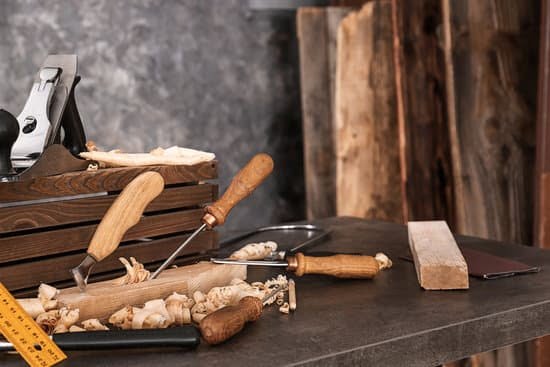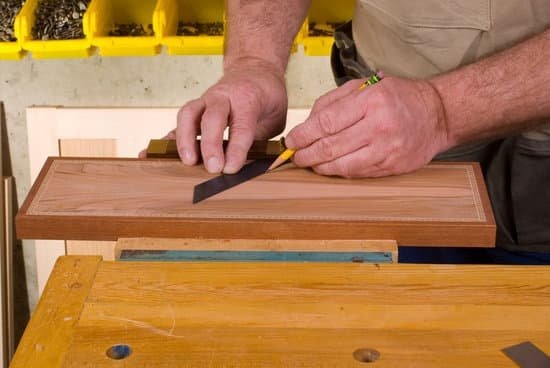Are you wondering what epoxy to buy for woodworking? Epoxy has become an essential part of woodworking projects due to its strength, durability, and versatility. In this article, we will explore the different types of epoxy available for woodworking, factors to consider when choosing the right epoxy, how to apply it in your projects, common mistakes to avoid, and safety precautions when working with epoxy.
Epoxy is a popular adhesive and coating for woodworking because of its ability to bond well with wood and provide a smooth, durable finish. When it comes to choosing the right epoxy for your woodworking projects, there are several factors to consider. From the type of wood you’re working with to the specific project requirements, understanding these factors will help you make an informed decision.
In addition to discussing the different types of epoxy available for woodworking and how they are used, we will also cover important safety precautions that need to be taken when working with epoxy. By the end of this article, you will have a comprehensive understanding of how to choose the right epoxy for your woodworking needs and how to use it effectively in your projects.
Whether you’re a seasoned woodworker or just starting out, mastering the art of using epoxy in your woodworking projects can take your craftsmanship to the next level.
Types of Epoxy for Woodworking
When it comes to woodworking, choosing the right epoxy is crucial for the success of your project. There are several types of epoxy that can be used for woodworking, each with its own unique properties and uses. One popular option is clear epoxy, which is often used for filling cracks, knots, and other imperfections in wood. Another type is laminating epoxy, which is commonly used for bonding layers of wood together to create a strong and durable finish.
A third option is colored epoxy, which can add a decorative element to your woodworking project. This type of epoxy comes in a variety of colors and can be used to create intricate designs and patterns on the surface of the wood. Other types of epoxy include casting resin, which is ideal for creating 3D shapes and embedding objects in wood, and marine-grade epoxy, which is designed to withstand exposure to water and other elements.
When deciding what epoxy to buy for woodworking, it’s important to consider the specific needs of your project. Factors such as the type of wood you’re working with, the size of the project, and whether it will be exposed to moisture or outdoor elements will all influence your choice. Additionally, consider the desired finish – whether you want a clear or colored epoxy – and how you plan to apply it.
| Epoxy Type | Best Used For |
|---|---|
| Clear Epoxy | Filling cracks and imperfections |
| Laminating Epoxy | Bonding layers of wood together |
| Colored Epoxy | Decorative designs on wood surface |
Factors to Consider When Choosing Epoxy for Woodworking
When selecting the right epoxy for woodworking projects, several factors need to be taken into account to ensure that the end result meets expectations. Choosing the wrong epoxy can result in a failed project, so it’s important to carefully consider the following factors before making a purchase:
- Type of Wood: Different types of wood may require different types of epoxy. Some woods are more porous and may require an epoxy with better penetration, while others may need a thicker epoxy to fill in gaps and imperfections.
- Project Requirements: Consider the specific requirements of your woodworking project. Are you looking for a clear finish? Do you need a quick-drying epoxy or one with a longer working time? Understanding the needs of your project will help you decide which type of epoxy is best suited for the job.
- Strength and Durability: Depending on the intended use of the final piece, it’s important to choose an epoxy that provides the necessary strength and durability. For example, if you’re creating a tabletop, you’ll want an epoxy that can withstand heat and heavy use.
In addition to these factors, it’s also essential to consider whether the epoxy is designed specifically for woodworking purposes. Some epoxies are formulated with additives that make them more suitable for bonding wood, while others may be better suited for other materials such as metal or plastic. Lastly, always take into consideration any environmental or health considerations when choosing which product to buy.
Ultimately, taking these factors into account will help ensure that you select the right epoxy for your woodworking project and achieve professional-quality results.
How to Apply Epoxy in Woodworking Projects
Preparing the Wood Surface
Before applying epoxy to a woodworking project, it is essential to properly prepare the wood surface. This involves sanding the wood to create a smooth and even surface for the epoxy to adhere to. It’s important to remove any dust from the surface using a tack cloth or compressed air.
Mixing and Applying Epoxy
When working with epoxy, it is crucial to follow the manufacturer’s instructions for mixing the resin and hardener. Improperly mixed epoxy can result in a weak bond or a sticky finish. Once the epoxy is mixed, apply it evenly to the wood surface using a brush or spreader. It’s important to work quickly, as epoxy has a limited working time before it begins to cure.
Finishing Techniques
After applying the epoxy, it’s important to address any bubbles that may have formed during the application process. This can be done by carefully using a heat gun or propane torch to gently remove them. Additionally, it may be necessary to apply multiple coats of epoxy for certain projects, so be sure to follow the manufacturer’s recommendations for additional layers.
By following these steps for applying epoxy in woodworking projects, you can ensure that your finished piece has a durable and professional-looking finish that will protect and enhance the natural beauty of the wood.
Common Mistakes to Avoid When Using Epoxy for Woodworking
When it comes to using epoxy for woodworking, there are several common mistakes that every woodworker should be aware of in order to achieve a successful project. One of the most common mistakes is not properly preparing the wood surface before applying the epoxy. Failure to clean, sand, and properly prepare the wood can result in a poor bond and finish.
Another common mistake is not following the manufacturer’s instructions for mixing the epoxy. This can lead to an improper cure, resulting in a soft or sticky finish. It’s important to measure and mix the epoxy components accurately to ensure a strong and durable bond.
Additionally, rushing the application process is another mistake to avoid. Epoxy requires patience as it cures, so taking your time during the application process is crucial. Rushing can lead to uneven coverage and air bubbles in the finish.
| Common Mistake | Consequence |
|---|---|
| Improperly preparing wood surface | Poor bond and finish |
| Not following manufacturer’s mixing instructions | Improper cure, soft or sticky finish |
| Rushing the application process | Uneven coverage, air bubbles in finish |
Safety Precautions When Working With Epoxy
Working with epoxy in woodworking projects can be a rewarding experience, but it’s important to prioritize safety at all times. Epoxy can be potentially hazardous if not handled properly, so taking the necessary precautions is crucial. Here are some essential safety measures to keep in mind when working with epoxy:
- Ensure proper ventilation: Epoxy emits strong fumes that can be harmful if inhaled in large quantities. Always work in a well-ventilated area or use a respirator to protect your lungs from the fumes.
- Wear protective gear: When handling epoxy, it’s important to protect your skin and eyes. Wear gloves to prevent direct contact with the resin and hardener, and use safety goggles to shield your eyes from any potential splashes.
- Follow mixing ratios carefully: Each epoxy product comes with specific mixing ratios for its resin and hardener. It’s crucial to measure and mix them accurately according to the manufacturer’s instructions to ensure the epoxy cures properly without any safety risks.
Additionally, it’s important to keep in mind proper disposal of leftover or expired epoxy, as well as cleaning up any spills or drips promptly to prevent accidents. By prioritizing safety when working with epoxy, you can enjoy your woodworking projects while minimizing risks to yourself and others.
Remember that choosing the right type of epoxy for your woodworking project is also key. For more information on what epoxy to buy for woodworking feel free tto check out our other sections in this article.
Final Thoughts on Choosing the Right Epoxy for Woodworking
In conclusion, when it comes to choosing the right epoxy for woodworking, there are several factors to consider. The type of project, the desired finish, and the working conditions all play a role in determining which epoxy will work best for your needs. It’s important to carefully assess these factors before making a decision on what epoxy to buy for woodworking.
Additionally, it’s crucial to pay attention to safety precautions when working with epoxy. This includes proper ventilation, wearing protective gear, and following the manufacturer’s instructions for handling and disposing of the product. By taking these precautions seriously, woodworkers can ensure a safe and successful experience when using epoxy in their projects.
Ultimately, the right epoxy for woodworking will depend on individual preferences and specific project requirements. Whether it’s a clear epoxy for a glossy finish or a colored epoxy for decorative purposes, woodworkers should take the time to research and test different options before making a final decision. By carefully considering all factors and prioritizing safety, woodworkers can achieve excellent results with their epoxy projects.
Frequently Asked Questions
What Epoxy Is Best for Woodworking?
The best epoxy for woodworking is typically a two-part epoxy that is specifically designed for wood. It should have a strong bond, resistance to water and chemicals, and be able to withstand sanding and staining.
Additionally, it’s important to choose an epoxy that has a long enough working time so that you have enough time to apply it before it starts to harden.
What Kind of Epoxy Do You Use for Wood Turning?
For wood turning, it’s best to use an epoxy resin that has a relatively low viscosity so that it can easily penetrate the wood and fill any voids or cracks. This type of epoxy is often used for stabilizing wood as well, which is important for creating strong and durable wood turned items.
Can You Apply Epoxy Directly to Wood?
Yes, you can apply epoxy directly to wood. In fact, this is a common practice in woodworking for filling voids, cracks, and knots in the wood.
However, it’s important to properly prepare the surface of the wood by sanding and cleaning it before applying the epoxy to ensure good adhesion. Additionally, some epoxies are specifically formulated for direct application on wood surfaces, so it’s important to choose the right type of epoxy for this purpose.

Hi everyone! I’m a woodworker and blogger, and this is my woodworking blog. In my blog, I share tips and tricks for woodworkers of all skill levels, as well as project ideas that you can try yourself.





